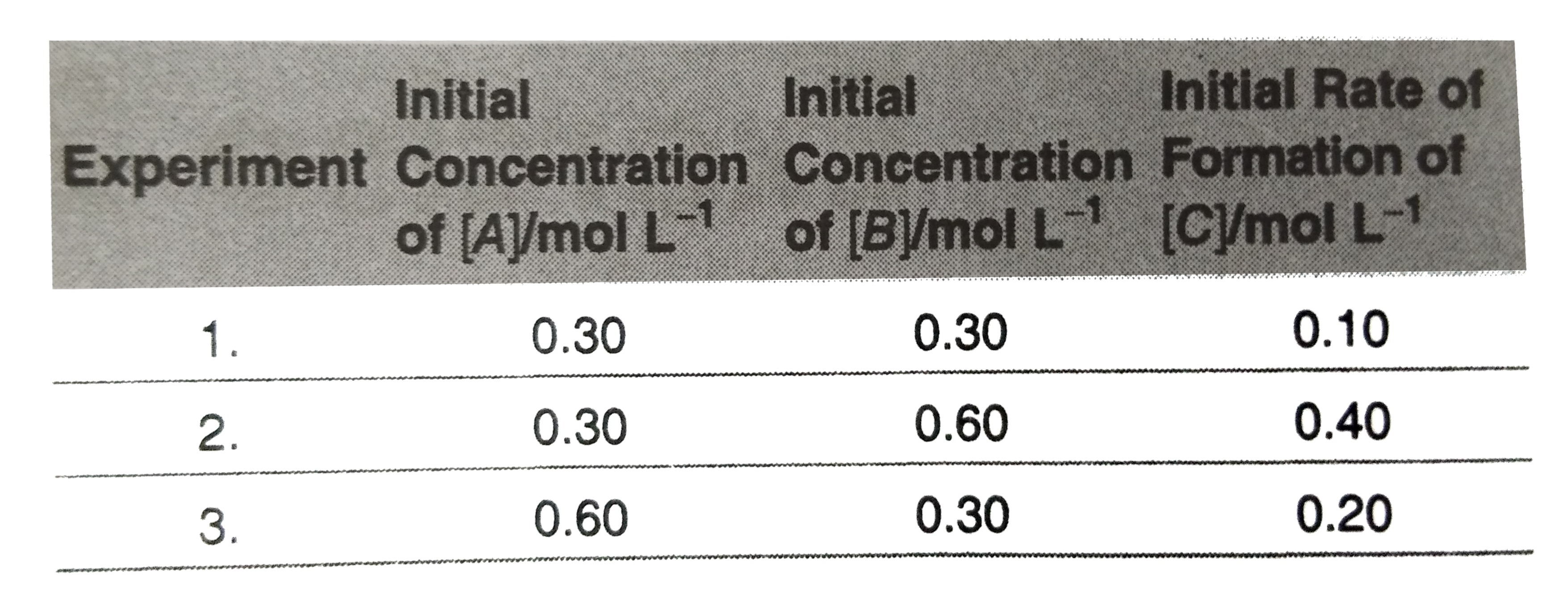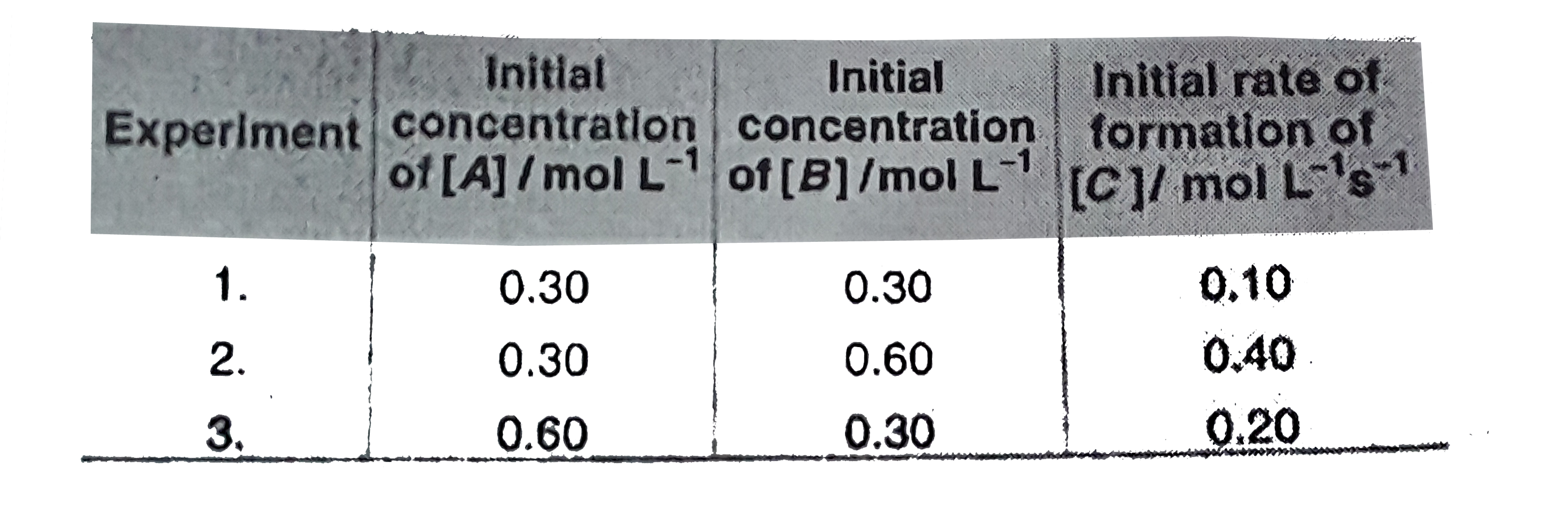Compounds A and B react according to the following chemical equation,
A(g)+2B(g)→2C(g)
Concentration of either A or B were changed keeping the concentrations of one of the reactants as constant and rates were measured as a function of initial concentration. ltbgt Following results were obtained . Choose the correct option for the rate equations for this reaction.

Rate=k[A]2[B]
Rate=k[A][B]2
Rate=k[A][B]
Rate=k[A]2[B]0
The correct Answer is:B

The above table suggests that the rate law expression would be
Rate=k[A][B]2
Topper's Solved these Questions
- CHEMICAL KINETICS BOOK - MHTCET PREVIOUS YEAR PAPERS AND PRACTICE PAPERSCHAPTER - CHEMICAL KINETICS EXERCISE - MHT CET CORNER
20 Videos
- CHEMICAL KINETICS BOOK - MHTCET PREVIOUS YEAR PAPERS AND PRACTICE PAPERSCHAPTER - CHEMICAL KINETICS EXERCISE - Exercise 1
63 Videos
- BIOMOLECULES BOOK - MHTCET PREVIOUS YEAR PAPERS AND PRACTICE PAPERSCHAPTER - BIOMOLECULES EXERCISE - MHT CET CORNER
24 Videos
- CHEMICAL THERMODYNAMICS AND ENERGETICBOOK - MHTCET PREVIOUS YEAR PAPERS AND PRACTICE PAPERSCHAPTER - CHEMICAL THERMODYNAMICS AND ENERGETICEXERCISE - MHT CET Corner
40 Videos
Similar Questions
Compounds 'A' and 'B' react according to the following chemical equation.
A(g)→2B(g)→2C(g)
Concentration of either 'A' or 'B' were changed Keeping the concentration of one of the reactants constant and rates were measured as a function of initial concentration. Following result were obtained.
Choose the correct option for the rate equations for this reaction.

View SolutionCompounds 'A' and 'B' react according to the following chemical equation.
A(g)→2B(g)→2C(g)
Concentration of either 'A' or 'B' were changed Keeping the concentration of one of the reactants constant and rates were measured as a function of initial concentration. Following result were obtained.
Choose the correct option for the rate equations for this reaction.

View Solution
Knowledge Check
Compounds A and B react according to the following chemical equation :
A(g)+2B(g)→2C(g)
Concentration of either A or B were changed keeping the concentrations of one of the reactant constants and rates were measured as a function of initial concentration, Following results were obtained.

Choose the correct option for the rate equations for this reaction.ARate = k[A]2[B]BRate = k[A][B]2CRate = k[A][B]DRate = k[A]2[B]0Compounds A and B react according to the following chemical equation :
A(g)+2B(g)→2C(g)
Concentration of either A or B were changed keeping the concentrations of one of the reactant constants and rates were measured as a function of initial concentration, Following results were obtained.

Choose the correct option for the rate equations for this reaction.ARate = k[A]2[B]BRate = k[A][B]2CRate = k[A][B]DRate = k[A]2[B]0Compounds 'A' and 'B' react according to the following chemical equation
A(g)+2B(g)→2C(g)
Concentration of either 'A' or 'B' were changed keeping the concentrations of one of the reactants constant and rates were measured as a function of initial concentration. Following results were obtained. Choose the correct option for the rate of equations for this reaction.
 ARate of = k[A]2[B]BRate = k[A][B]2CRate = k[A][B]DRate = k[A]2[B]−
ARate of = k[A]2[B]BRate = k[A][B]2CRate = k[A][B]DRate = k[A]2[B]−
Compounds 'A' and 'B' react according to the following chemical equation.
A(g)→2B(g)→2C(g)
Concentration of either 'A' or 'B' were changed Keeping the concentration of one of the reactants constant and rates were measured as a function of initial concentration. Following result were obtained.
Choose the correct option for the rate equations for this reaction.

View SolutionCompounds 'A' and 'B' react according to the following chemical equation.
A(g)→2B(g)→2C(g)
Concentration of either 'A' or 'B' were changed Keeping the concentration of one of the reactants constant and rates were measured as a function of initial concentration. Following result were obtained.
Choose the correct option for the rate equations for this reaction.

View SolutionCompounds 'A' and 'B' react according to the following chemical equation.
A(g)→2B(g)→2C(g)
Concentration of either 'A' or 'B' were changed Keeping the concentration of one of the reactants constant and rates were measured as a function of initial concentration. Following result were obtained.
Choose the correct option for the rate equations for this reaction.

View SolutionCompound 'A' and B react according to the following chemical equation.
A(g)+2B(g)→2C(g)
Concentration of either A or B were changed keeping the concentrations of one of the reactants constant and rates were mesured as a function of initial concentration. Following results were obtained. Choose the correct option for the rate equations for this reaction.
ExperimentInitial concentration of[A]/molL−1Initial concentration of[B]molL−1Initial rate of formation of[c]/molL−1s−110.300.300.1020.300.600.4030.600.300.20
View SolutionCompound 'A' and B react according to the following chemical equation.
A(g)+2B(g)→2C(g)
Concentration of either A or B were changed keeping the concentrations of one of the reactants constant and rates were mesured as a function of initial concentration. Following results were obtained. Choose the correct option for the rate equations for this reaction.
ExperimentInitial concentration of[A]/molL−1Initial concentration of[B]molL−1Initial rate of formation of[c]/molL−1s−110.300.300.1020.300.600.4030.600.300.20
View Solution
